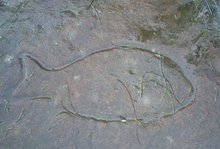 Sydney's drinking water,we are being told 'is no public health risk'.
Sydney's drinking water,we are being told 'is no public health risk'.
"A, there is nothing we can do about it;
B, it's a perfectly natural phenomenon which is a response of lots of nutrients being washed into the water;
C, it's not toxic”.
The 'non toxic' growth of blue-green algae expanded over the weekend from 14 to 26 km (image) in Warragamba Dam. Daily 'water quality results' do not show up any 'blooming'.
While industry and government representatives are being instructed on 'water quality management and health risk reduction' the public is ensured that Microcystis aeruginosa (pdf) species is only 'potentially harmful', but you ”may notice a change in taste and odour.”
Australia's Water Quality and Treatment states the following in its 'Blue Green Algae Guide (pdf)
“Blue-green algae produce three main types of toxin:
• Endotoxins are thought to produce allergic reactions, skin rashes, irritation of the eyes, and gastroenteritis.
• Neurotoxins damage nerves and can cause muscle tremors, especially in the muscles animals and people need to breath.
• Hepatotoxins damage the liver. They may also increase the risk of certain types of cancer.
To put the toxicity of blue-green algae in perspective, Microcystis, one of the blue-green algae found in Australian waters, produces a toxin called microcystinLR. Microcystin LR is 200 times more toxic than cyanide.
Blue-green algal toxins are colourless, odourless,and can remain present in the water weeks after the blue-green algae have disappeared. They are not destroyed by boiling affected water.”

A town water supply was closed down due to cyanobacteria (HABs) some time ago in NSW. WHO recommends that " levels of 10 cells mLˉ" of cyanobacteria should not get in contact with humans. “The major route of human exposure to cyanobacterial toxins is the consumption of drinking water” (WHO, pdf) Unfortunately we are not told the levels of Sydney's bloom in the drinking water or the ocean.
In some places “the highly toxic algae Microcystis aeruginosa” threatens human health. “Health experts warn that even modest exposure to the toxin produced by the algae, called microcystin, can lead to skin rashes, vomiting, and diarrhea.” Various stakeholders believe that “ the regional water board not only has the authority but the mandate to protect the public from toxins like these in water bodies.”
Once HABs are present in the 'red surf' of the ocean, the sea breeze blows toxic aerosol over the coastal residents. “During the red tide, admissions for pneumonia, bronchitis, asthma, sinus infections and similar afflictions rose 54%.” Surf club's sign read: "Some Red Tide = Coughs. Sneezes. Dead Fishes." People wear masks.
“A scientific consensus is emerging that commercial agriculture and coastal development, in particular, promote the spread of harmful algae. They generate runoff rich in nitrogen, phosphorous and other nutrients that sustain these microscopic aquatic plants. In essence, researchers say, modern society is force-feeding the oceans with the basic ingredients of Miracle-Gro.”
“Industrial society is overdosing the oceans with basic nutrients - the nitrogen, carbon, iron and phosphorous compounds that curl out of smokestacks and tailpipes, wash into the sea from fertilized lawns and cropland, seep out of septic tanks and gush from sewer pipes.”
Domestic, industrial and agricultural wastes - 'cultural eutrophication' stimulate the growth of HABs. The list of causes via non point source or Nonpoint Source Pollution seems endless:
- Sewage, partially treated human waste ,septic tanks, untreated dog faeces
- Runoff from cities, suburbs (green lawns, sports-fields, cocktails of chemicals
- Urban 'greening': lawns, use of fertilizers
- Farm run off
- Ballast water from ships
“Toxic algae thrive on the same elements that turn lawns green and make crops grow — nitrogen, phosphorus and iron” Sickness and mortality (pdf) is brought on to marine mammals, fish and birds. Dogs and livestock have been know to drop dead within 30 minutes.
“There is a growing public concern about the environmental quality of most major rivers, estuaries and coastal waters near Australia's large population centres where discharges of industrial, domestic and agricultural wastes are raising the nutrient levels in the water." Some areas of Australian coasts are so polluted, that it “can cause selective inhibition of phytoplankton species”
“The long-term solution is reducing the volume of nutrients by controlling sewage, fertilizers, industrial effluents and agricultural runoff." (pdf) Transparent, accountability for the management of drinking water, water bodies and the ocean. Standards and monitoring for toxins. Bottom up, concerned stakeholders.
Previous:
Pt I, On the Use of Water and the Creation of dead Zone
Drinking Water & Healthy Water Bodies Pt II
Drinking water security, sewage and emerging bugs III
Antarctic Seals on Sydney Beaches - “ The anatomy of a sea lion is not too dissimilar to the human anatomy”
Interesting reading/resources:
- Altered Oceans, Kenneth R. Weiss, Usha Lee McFarling and Rick Loomis
- Cyanobacterial toxins: Microcystin-LR in Drinking-water, WHO, pdf
- Drinking water facts: providing scientific information about drinking water for Australian communities
- Tribe, Fishermen, Conservationists Sue California over Toxic Discharges to Klamath River Groups want state to regulate PacifiCorp’s Algal Toxins
- Marine phytoplankton communities in the Australian region: current status and the future threats
- An Algae’s Tale - Three Billion Years of Gas Bubbles,Oxygen and, More Recently, Dog Doo (easy reading)
- Red Tide Image, NZ, MIT
- Daily Drinking Water Quality Results, Australia
Images: Water, Skeleton Installation 'Habibi' by Adel Abdessemed, video by dotAtelier












No comments:
Post a Comment